ICT Project Management: Methodologies and Comparison
VerifiedAdded on 2021/04/24
|6
|1282
|59
Report
AI Summary
This report delves into the realm of ICT project management, providing a comprehensive overview of project methodologies. It defines project methodology, emphasizing its role in planning, executing, and successfully completing projects. The report explores two prominent methodologies: PMBOK (Project Management Body of Knowledge) and PRINCE2 (Projects IN Controlled Environments), highlighting their key differences and similarities. PMBOK is presented as a knowledge-oriented, non-prescriptive approach giving more power to the project manager, while PRINCE2 is a process-oriented, team based methodology. The report also examines the relationship between PRINCE2 and the project life cycle, outlining the seven processes involved: starting up the project, initiating the project, directing the project, managing stage boundaries, controlling a stage, managing product delivery, and project closure. The report references various sources to support its analysis, providing a well-rounded understanding of ICT project management principles and practices.
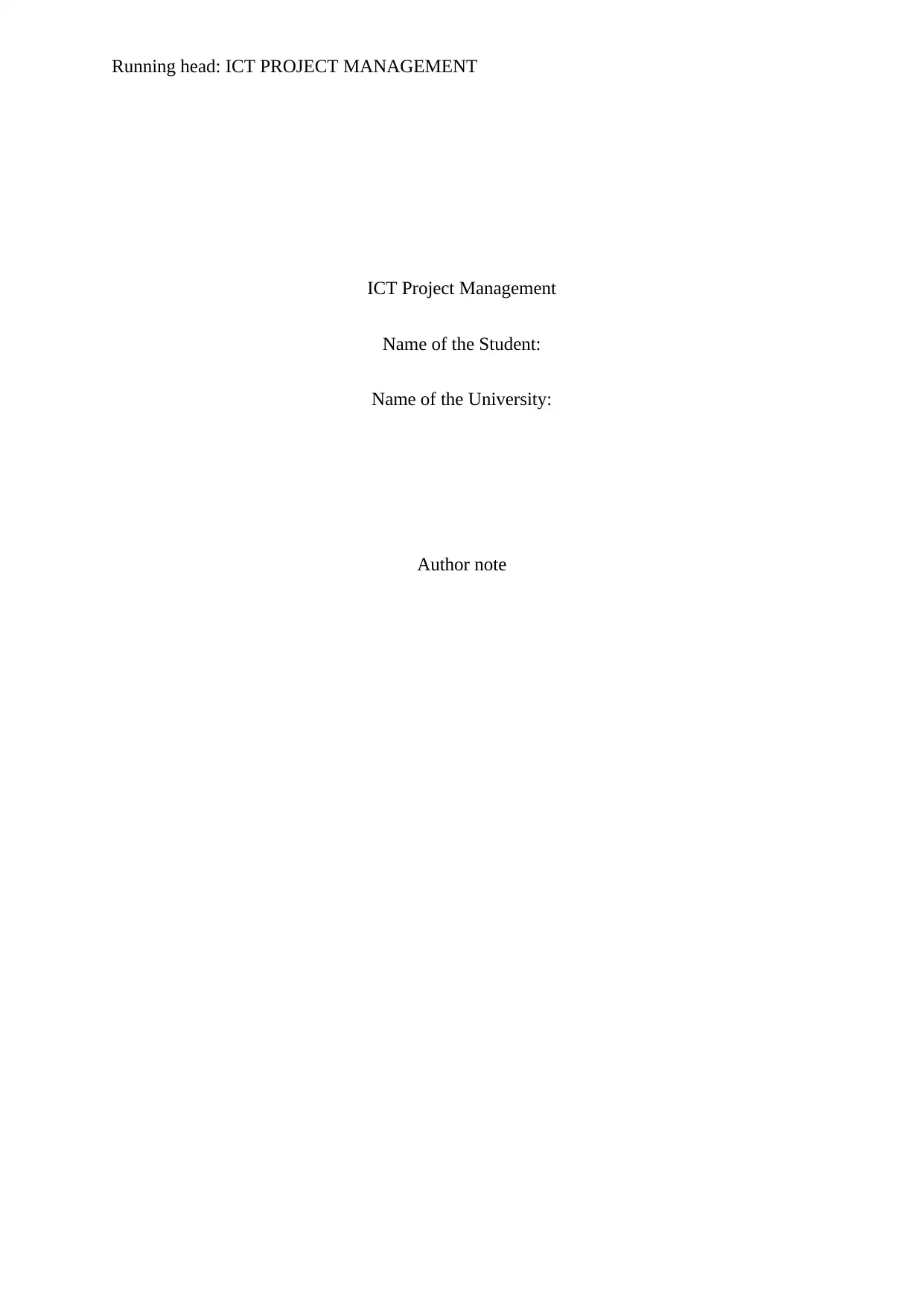
Running head: ICT PROJECT MANAGEMENT
ICT Project Management
Name of the Student:
Name of the University:
Author note
ICT Project Management
Name of the Student:
Name of the University:
Author note
Paraphrase This Document
Need a fresh take? Get an instant paraphrase of this document with our AI Paraphraser
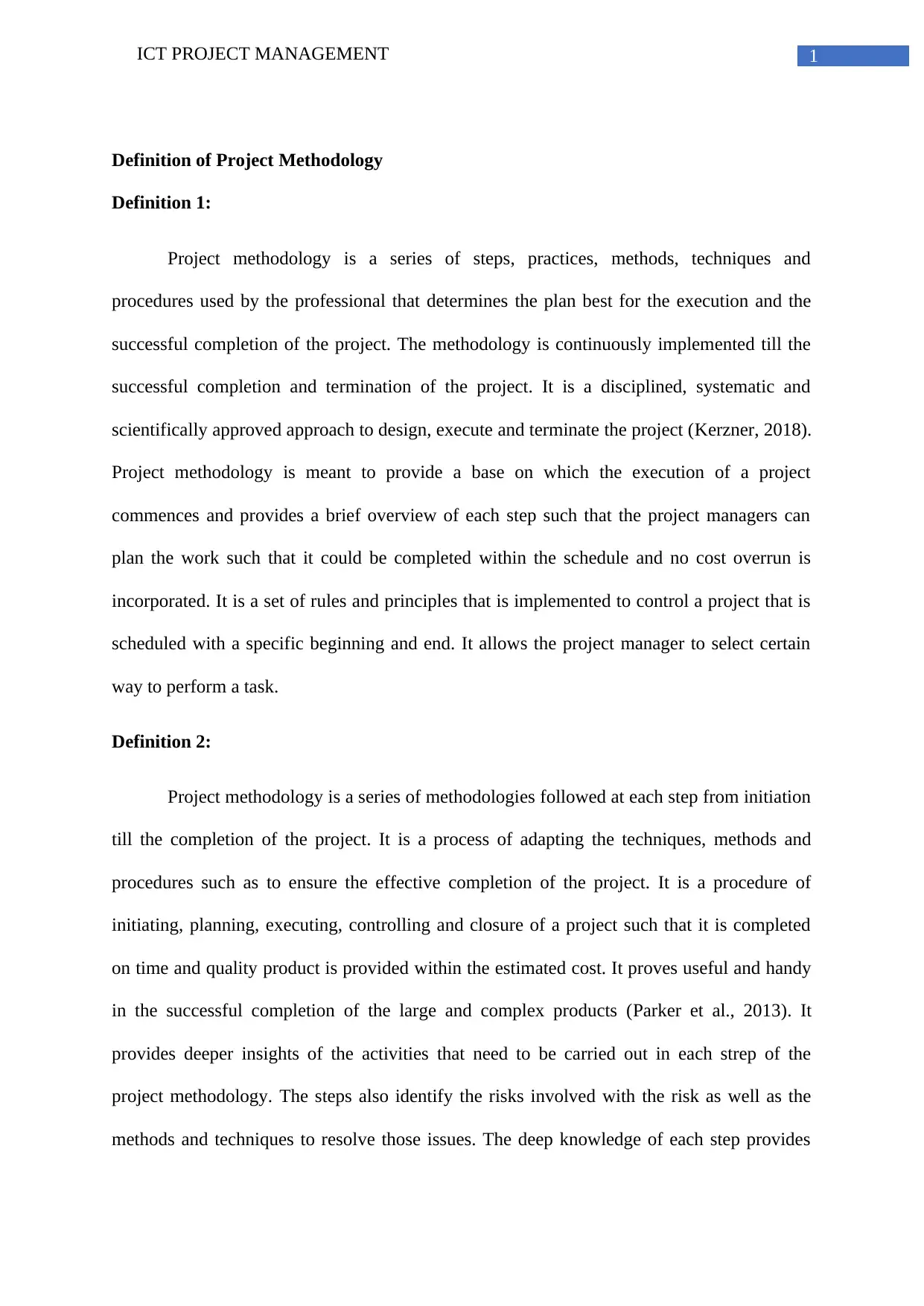
1ICT PROJECT MANAGEMENT
Definition of Project Methodology
Definition 1:
Project methodology is a series of steps, practices, methods, techniques and
procedures used by the professional that determines the plan best for the execution and the
successful completion of the project. The methodology is continuously implemented till the
successful completion and termination of the project. It is a disciplined, systematic and
scientifically approved approach to design, execute and terminate the project (Kerzner, 2018).
Project methodology is meant to provide a base on which the execution of a project
commences and provides a brief overview of each step such that the project managers can
plan the work such that it could be completed within the schedule and no cost overrun is
incorporated. It is a set of rules and principles that is implemented to control a project that is
scheduled with a specific beginning and end. It allows the project manager to select certain
way to perform a task.
Definition 2:
Project methodology is a series of methodologies followed at each step from initiation
till the completion of the project. It is a process of adapting the techniques, methods and
procedures such as to ensure the effective completion of the project. It is a procedure of
initiating, planning, executing, controlling and closure of a project such that it is completed
on time and quality product is provided within the estimated cost. It proves useful and handy
in the successful completion of the large and complex products (Parker et al., 2013). It
provides deeper insights of the activities that need to be carried out in each strep of the
project methodology. The steps also identify the risks involved with the risk as well as the
methods and techniques to resolve those issues. The deep knowledge of each step provides
Definition of Project Methodology
Definition 1:
Project methodology is a series of steps, practices, methods, techniques and
procedures used by the professional that determines the plan best for the execution and the
successful completion of the project. The methodology is continuously implemented till the
successful completion and termination of the project. It is a disciplined, systematic and
scientifically approved approach to design, execute and terminate the project (Kerzner, 2018).
Project methodology is meant to provide a base on which the execution of a project
commences and provides a brief overview of each step such that the project managers can
plan the work such that it could be completed within the schedule and no cost overrun is
incorporated. It is a set of rules and principles that is implemented to control a project that is
scheduled with a specific beginning and end. It allows the project manager to select certain
way to perform a task.
Definition 2:
Project methodology is a series of methodologies followed at each step from initiation
till the completion of the project. It is a process of adapting the techniques, methods and
procedures such as to ensure the effective completion of the project. It is a procedure of
initiating, planning, executing, controlling and closure of a project such that it is completed
on time and quality product is provided within the estimated cost. It proves useful and handy
in the successful completion of the large and complex products (Parker et al., 2013). It
provides deeper insights of the activities that need to be carried out in each strep of the
project methodology. The steps also identify the risks involved with the risk as well as the
methods and techniques to resolve those issues. The deep knowledge of each step provides
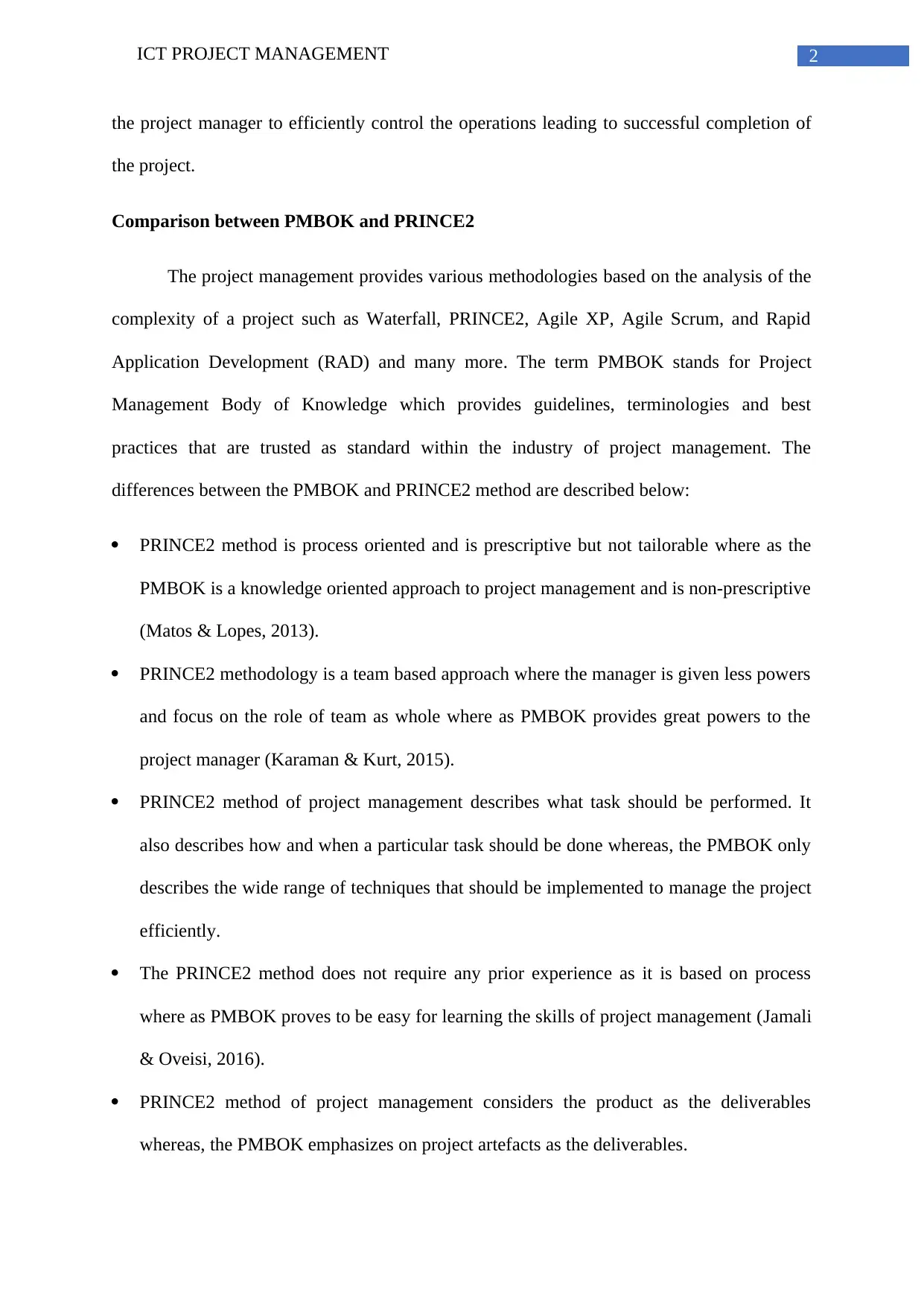
2ICT PROJECT MANAGEMENT
the project manager to efficiently control the operations leading to successful completion of
the project.
Comparison between PMBOK and PRINCE2
The project management provides various methodologies based on the analysis of the
complexity of a project such as Waterfall, PRINCE2, Agile XP, Agile Scrum, and Rapid
Application Development (RAD) and many more. The term PMBOK stands for Project
Management Body of Knowledge which provides guidelines, terminologies and best
practices that are trusted as standard within the industry of project management. The
differences between the PMBOK and PRINCE2 method are described below:
PRINCE2 method is process oriented and is prescriptive but not tailorable where as the
PMBOK is a knowledge oriented approach to project management and is non-prescriptive
(Matos & Lopes, 2013).
PRINCE2 methodology is a team based approach where the manager is given less powers
and focus on the role of team as whole where as PMBOK provides great powers to the
project manager (Karaman & Kurt, 2015).
PRINCE2 method of project management describes what task should be performed. It
also describes how and when a particular task should be done whereas, the PMBOK only
describes the wide range of techniques that should be implemented to manage the project
efficiently.
The PRINCE2 method does not require any prior experience as it is based on process
where as PMBOK proves to be easy for learning the skills of project management (Jamali
& Oveisi, 2016).
PRINCE2 method of project management considers the product as the deliverables
whereas, the PMBOK emphasizes on project artefacts as the deliverables.
the project manager to efficiently control the operations leading to successful completion of
the project.
Comparison between PMBOK and PRINCE2
The project management provides various methodologies based on the analysis of the
complexity of a project such as Waterfall, PRINCE2, Agile XP, Agile Scrum, and Rapid
Application Development (RAD) and many more. The term PMBOK stands for Project
Management Body of Knowledge which provides guidelines, terminologies and best
practices that are trusted as standard within the industry of project management. The
differences between the PMBOK and PRINCE2 method are described below:
PRINCE2 method is process oriented and is prescriptive but not tailorable where as the
PMBOK is a knowledge oriented approach to project management and is non-prescriptive
(Matos & Lopes, 2013).
PRINCE2 methodology is a team based approach where the manager is given less powers
and focus on the role of team as whole where as PMBOK provides great powers to the
project manager (Karaman & Kurt, 2015).
PRINCE2 method of project management describes what task should be performed. It
also describes how and when a particular task should be done whereas, the PMBOK only
describes the wide range of techniques that should be implemented to manage the project
efficiently.
The PRINCE2 method does not require any prior experience as it is based on process
where as PMBOK proves to be easy for learning the skills of project management (Jamali
& Oveisi, 2016).
PRINCE2 method of project management considers the product as the deliverables
whereas, the PMBOK emphasizes on project artefacts as the deliverables.
⊘ This is a preview!⊘
Do you want full access?
Subscribe today to unlock all pages.

Trusted by 1+ million students worldwide
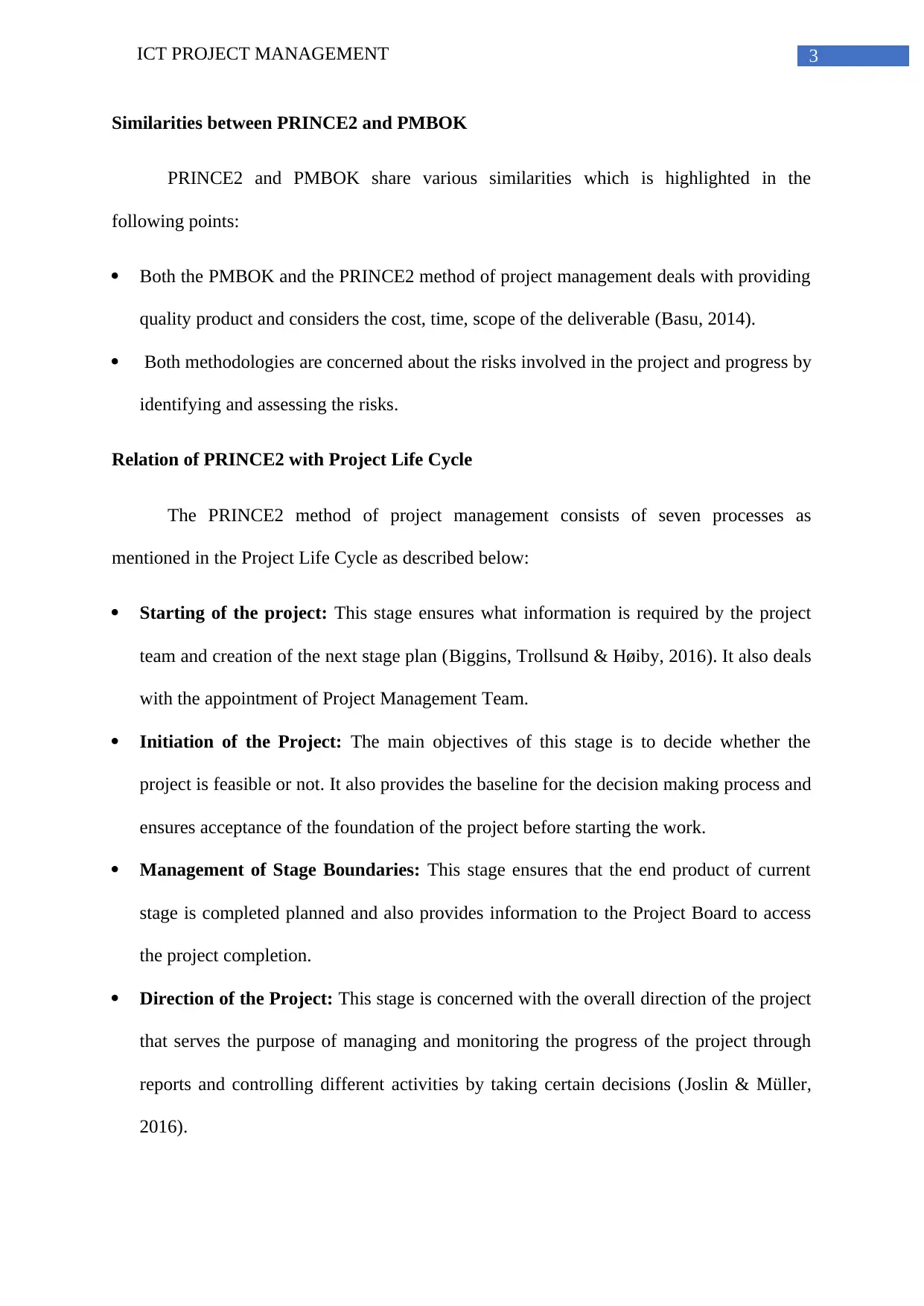
3ICT PROJECT MANAGEMENT
Similarities between PRINCE2 and PMBOK
PRINCE2 and PMBOK share various similarities which is highlighted in the
following points:
Both the PMBOK and the PRINCE2 method of project management deals with providing
quality product and considers the cost, time, scope of the deliverable (Basu, 2014).
Both methodologies are concerned about the risks involved in the project and progress by
identifying and assessing the risks.
Relation of PRINCE2 with Project Life Cycle
The PRINCE2 method of project management consists of seven processes as
mentioned in the Project Life Cycle as described below:
Starting of the project: This stage ensures what information is required by the project
team and creation of the next stage plan (Biggins, Trollsund & Høiby, 2016). It also deals
with the appointment of Project Management Team.
Initiation of the Project: The main objectives of this stage is to decide whether the
project is feasible or not. It also provides the baseline for the decision making process and
ensures acceptance of the foundation of the project before starting the work.
Management of Stage Boundaries: This stage ensures that the end product of current
stage is completed planned and also provides information to the Project Board to access
the project completion.
Direction of the Project: This stage is concerned with the overall direction of the project
that serves the purpose of managing and monitoring the progress of the project through
reports and controlling different activities by taking certain decisions (Joslin & Müller,
2016).
Similarities between PRINCE2 and PMBOK
PRINCE2 and PMBOK share various similarities which is highlighted in the
following points:
Both the PMBOK and the PRINCE2 method of project management deals with providing
quality product and considers the cost, time, scope of the deliverable (Basu, 2014).
Both methodologies are concerned about the risks involved in the project and progress by
identifying and assessing the risks.
Relation of PRINCE2 with Project Life Cycle
The PRINCE2 method of project management consists of seven processes as
mentioned in the Project Life Cycle as described below:
Starting of the project: This stage ensures what information is required by the project
team and creation of the next stage plan (Biggins, Trollsund & Høiby, 2016). It also deals
with the appointment of Project Management Team.
Initiation of the Project: The main objectives of this stage is to decide whether the
project is feasible or not. It also provides the baseline for the decision making process and
ensures acceptance of the foundation of the project before starting the work.
Management of Stage Boundaries: This stage ensures that the end product of current
stage is completed planned and also provides information to the Project Board to access
the project completion.
Direction of the Project: This stage is concerned with the overall direction of the project
that serves the purpose of managing and monitoring the progress of the project through
reports and controlling different activities by taking certain decisions (Joslin & Müller,
2016).
Paraphrase This Document
Need a fresh take? Get an instant paraphrase of this document with our AI Paraphraser
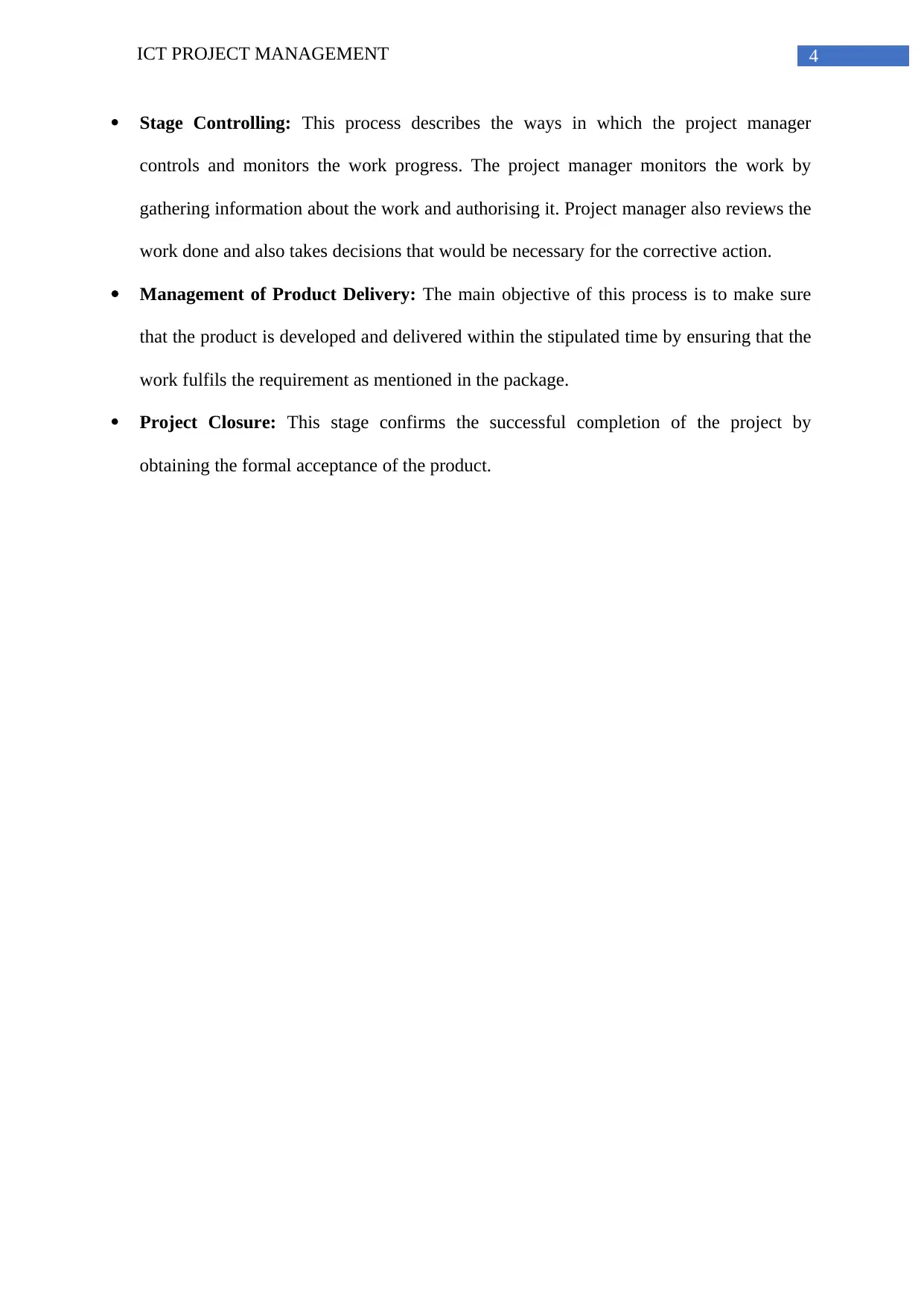
4ICT PROJECT MANAGEMENT
Stage Controlling: This process describes the ways in which the project manager
controls and monitors the work progress. The project manager monitors the work by
gathering information about the work and authorising it. Project manager also reviews the
work done and also takes decisions that would be necessary for the corrective action.
Management of Product Delivery: The main objective of this process is to make sure
that the product is developed and delivered within the stipulated time by ensuring that the
work fulfils the requirement as mentioned in the package.
Project Closure: This stage confirms the successful completion of the project by
obtaining the formal acceptance of the product.
Stage Controlling: This process describes the ways in which the project manager
controls and monitors the work progress. The project manager monitors the work by
gathering information about the work and authorising it. Project manager also reviews the
work done and also takes decisions that would be necessary for the corrective action.
Management of Product Delivery: The main objective of this process is to make sure
that the product is developed and delivered within the stipulated time by ensuring that the
work fulfils the requirement as mentioned in the package.
Project Closure: This stage confirms the successful completion of the project by
obtaining the formal acceptance of the product.
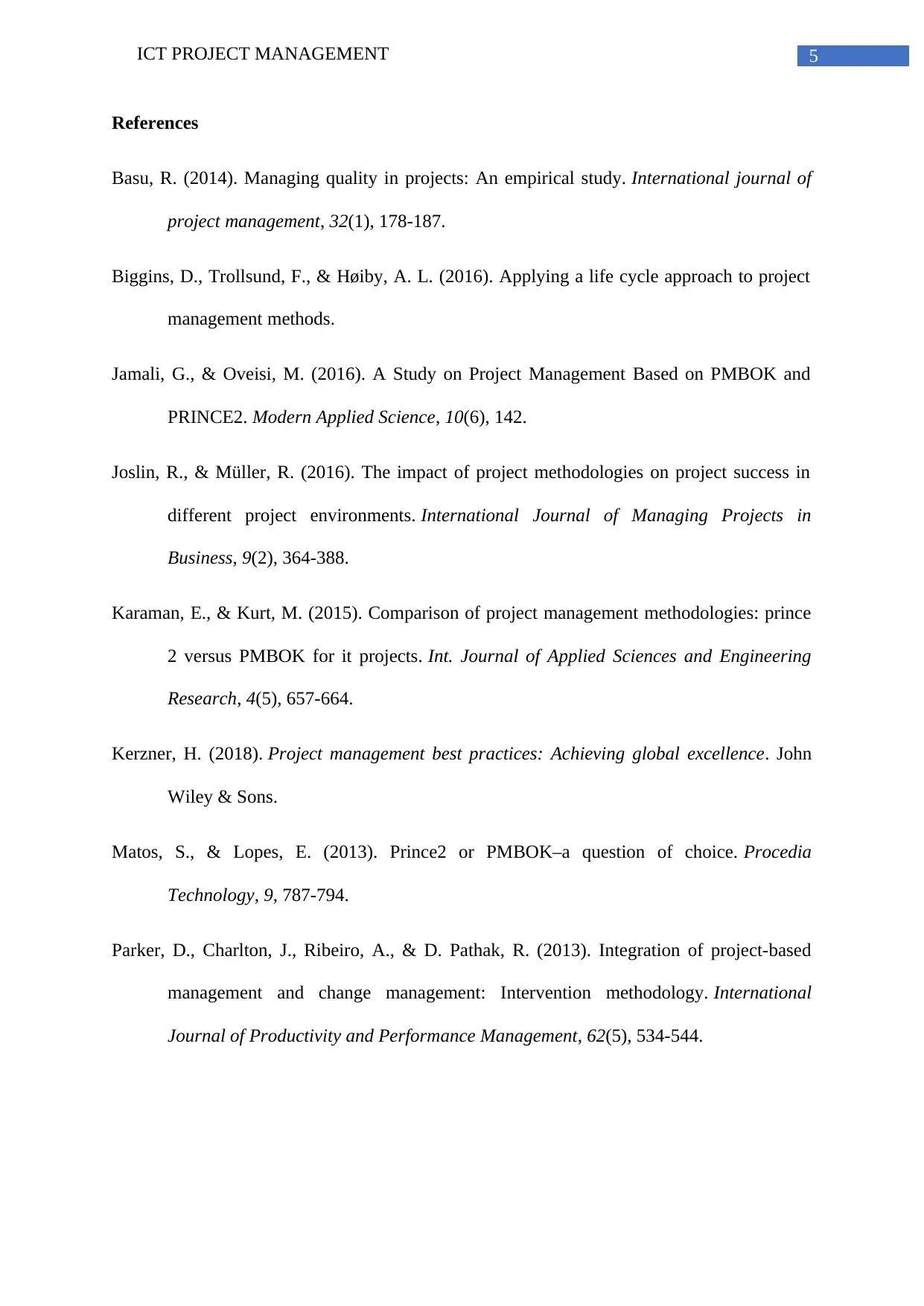
5ICT PROJECT MANAGEMENT
References
Basu, R. (2014). Managing quality in projects: An empirical study. International journal of
project management, 32(1), 178-187.
Biggins, D., Trollsund, F., & Høiby, A. L. (2016). Applying a life cycle approach to project
management methods.
Jamali, G., & Oveisi, M. (2016). A Study on Project Management Based on PMBOK and
PRINCE2. Modern Applied Science, 10(6), 142.
Joslin, R., & Müller, R. (2016). The impact of project methodologies on project success in
different project environments. International Journal of Managing Projects in
Business, 9(2), 364-388.
Karaman, E., & Kurt, M. (2015). Comparison of project management methodologies: prince
2 versus PMBOK for it projects. Int. Journal of Applied Sciences and Engineering
Research, 4(5), 657-664.
Kerzner, H. (2018). Project management best practices: Achieving global excellence. John
Wiley & Sons.
Matos, S., & Lopes, E. (2013). Prince2 or PMBOK–a question of choice. Procedia
Technology, 9, 787-794.
Parker, D., Charlton, J., Ribeiro, A., & D. Pathak, R. (2013). Integration of project-based
management and change management: Intervention methodology. International
Journal of Productivity and Performance Management, 62(5), 534-544.
References
Basu, R. (2014). Managing quality in projects: An empirical study. International journal of
project management, 32(1), 178-187.
Biggins, D., Trollsund, F., & Høiby, A. L. (2016). Applying a life cycle approach to project
management methods.
Jamali, G., & Oveisi, M. (2016). A Study on Project Management Based on PMBOK and
PRINCE2. Modern Applied Science, 10(6), 142.
Joslin, R., & Müller, R. (2016). The impact of project methodologies on project success in
different project environments. International Journal of Managing Projects in
Business, 9(2), 364-388.
Karaman, E., & Kurt, M. (2015). Comparison of project management methodologies: prince
2 versus PMBOK for it projects. Int. Journal of Applied Sciences and Engineering
Research, 4(5), 657-664.
Kerzner, H. (2018). Project management best practices: Achieving global excellence. John
Wiley & Sons.
Matos, S., & Lopes, E. (2013). Prince2 or PMBOK–a question of choice. Procedia
Technology, 9, 787-794.
Parker, D., Charlton, J., Ribeiro, A., & D. Pathak, R. (2013). Integration of project-based
management and change management: Intervention methodology. International
Journal of Productivity and Performance Management, 62(5), 534-544.
⊘ This is a preview!⊘
Do you want full access?
Subscribe today to unlock all pages.

Trusted by 1+ million students worldwide
1 out of 6
Related Documents
Your All-in-One AI-Powered Toolkit for Academic Success.
+13062052269
info@desklib.com
Available 24*7 on WhatsApp / Email
![[object Object]](/_next/static/media/star-bottom.7253800d.svg)
Unlock your academic potential
Copyright © 2020–2025 A2Z Services. All Rights Reserved. Developed and managed by ZUCOL.





